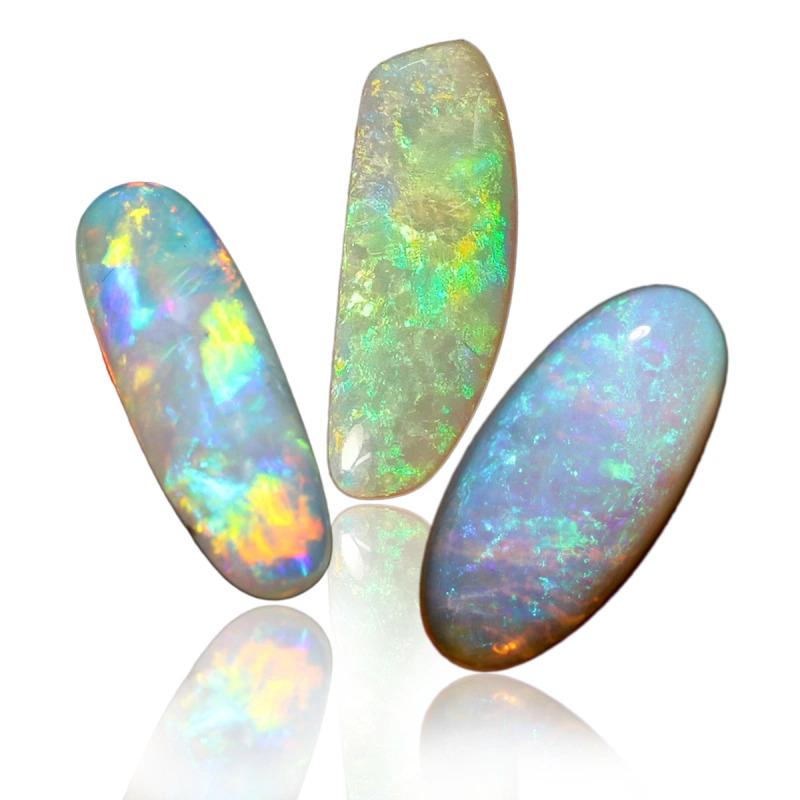
发布时间8th May 2018
修改于17th Nov 2025
南澳大利亚蛋白石矿区
南澳大利亚在澳大利亚蛋白石开采方面有着悠久的历史。它是最早开采蛋白石的地区之一,曾经催生出繁荣的城镇。如今,随着更受欢迎的黑蛋白石的发现,南澳大利亚的蛋白石矿区开采速度放缓,甚至已经停止。以下是南澳大利亚主要蛋白石矿区的列表。
明塔比蛋白石矿区
明塔比曾是仅次于库伯佩迪的第二大蛋白石产地,如今产量却很低。原因有很多,其中最主要的可能是原住民土地所有权(原住民收回土地的权利)的限制。尽管如此,明塔比仍然出产一些优质蛋白石。 
1998年8月的一次探访中,我有幸见到了一块色泽艳丽的纯红色蛋白石,价值数千美元。明塔比也以出产优质黑蛋白石而闻名,其品质与格拉温出产的蛋白石相似,偶尔还能见到一些与闪电岭出产的蛋白石几乎一模一样的宝石。
第一次世界大战结束后不久,库伯佩迪的土著居民率先出售了明塔比黑蛋白石。尽管一些矿工试图探寻其产地,但土著居民一直保守着这个秘密,直到20世纪30年代初。没有人会后悔去明塔比旅行。对于所有热爱旅行的人来说,这里都是必游之地,因为沙漠的美景令人叹为观止。此外,这里的生活设施也很完善。
从玛拉镇沿斯图尔特高速公路驱车 20 分钟即可到达,根据皮詹加拉土地权利法案,在玛拉镇警察局花费 5 美元即可获得许可,然后您就可以参观这片田野。
库伯佩迪
库伯佩迪位于阿德莱德和达尔文之间的斯图尔特高速公路沿线,距阿德莱德西北约800公里。由于气候极其贫瘠,许多当地居民将房屋建在了地下。
库伯佩迪矿区于1915年2月1日由一位14岁男孩发现,是世界上最大的蛋白石矿区,占澳大利亚蛋白石产量的80%。该矿区最初被称为“斯图尔特山脉蛋白石矿”。这位探险家于1858年途经此地,并以自己的名字命名了如今的库伯佩迪矿区。 
库伯佩迪(Coober Pedy)这个名字源于原住民语言,大致翻译过来就是“洞里的白人”。它是1920年6月新成立的发展委员会从四个提议的名称中选出的。
威利·哈钦森是阿德莱德淘金团伙中最年轻的成员,他在寻找水源时发现了蛋白石。八天后的2月9日,他们圈定了第一块矿权。当时正值昆士兰州历史上最严重的旱灾,迫使团伙成员四处寻找水源,年轻的威利则留下来照看营地。
威利在附近山脉的山麓扎营,他违抗命令,独自外出寻找水源。天黑后他仍未返回,队员们都开始担心起来。最终,他咧着嘴,肩上挎着半袋蛋白石,悠闲地走进了营地。他不仅找到了蛋白石,还找到了足够两周使用的水。完整的故事由他的父亲,探险队队长詹姆斯·哈奇森,于1938年4月7日在《阿德莱德纪事报》上发表。
由于地处偏远,最初几年只有少数矿工在此开采,1920年之前也没有买家光顾。第一次淘金热发生在1919年,使当地人口激增至数百人。在此期间,大量蛋白石被开采出来。
恶劣的环境使生活变得异常艰难。缺水始终是个难题,水往往需要多次循环利用才能排放。情况十分严峻,以至于政府在1924年建造了一个200万升的水库,部分解决了这个问题,使得每人每周的用水量可以配给110升。
20世纪30年代经济大萧条时期,蛋白石价格跌至谷底,该地区遭受重创。1945年,原住民妇女托迪·布莱恩特发现了八英里矿区,这一发现轰动一时。她在地表下20厘米处发现了蛋白石,这成为该矿区历史上的一个转折点,也为库伯佩迪未来的繁荣奠定了基础。
如今,库伯佩迪仍然是一个繁荣的矿业小镇,也是浅色蛋白石的产地。由于当地酷热难耐,矿工们会在地下挖掘房屋,这些地下住所中甚至包括游泳池和教堂,因此库伯佩迪也成为了热门的旅游景点。
安达穆卡
安达穆卡(Andamooka)是一个原住民名称,据信意为“大水潭”。该地区于1858年由约翰·麦克杜尔·斯图尔特发现,并于1872年开始有人定居。它是澳大利亚著名的蛋白石矿区之一,出产了一些迄今为止发现的最美丽的晶体蛋白石。
该地位于阿德莱德以北 600 公里处,有柏油路可达,人口流动性强,根据季节不同,常住人口在 600 至 1000 人之间。 
安达穆卡是澳大利亚唯一一个街道没有名字、主要干道是一条河床的小镇。自从道路铺设完毕后,许多旅游巴士都把这里作为北部之旅的第一站。
这片区域曾是一片广阔的内陆海,如今是澳大利亚众多蛋白石化史前化石的宝库。与化石一样,蛋白石也存在于地表以下10米深处,其中德国沟(German Gully)的一处蛋白石矿藏尤为丰富,甚至被誉为“英格兰银行”。
来到安达莫卡的游客很快就会发现,这里是远离现代生活压力的理想之地。当地居民热情友好,在废石堆里寻找蛋白石也是一次绝佳的度假体验。生活所需一应俱全,包括各种类型的住宿、超市、药店、咖啡馆、纪念品商店、野外考察和其他景点。
一场倾盆大雨促成了第一次发现,谢泼德捡到了第一块蛋白石。他和布鲁克斯都是沉箱工人,当时他们正要去查看马匹的情况,突然暴雨倾盆而下。他们把捡到的蛋白石带回营地,给之前在库伯佩迪工作过的奥克西·纽金特看,纽金特确认这是蛋白石。然而,纽金特在库伯佩迪没找到蛋白石,所以对寻找蛋白石失去了兴趣。
接下来的周末,布鲁克斯带着几块矿石回到农舍,给经理富利斯先生看。富利斯先生很感兴趣,便派他的簿记员艾伦·特雷洛尔和来自库伯佩迪的前蛋白石矿工帕迪·埃文斯去调查。
为了保守这一发现的秘密,防止人们蜂拥而至,他们采取了一切可能的措施。为了避免留下痕迹,任何人都不允许走同一条路线来回——就连富利斯先生每次探望那些矿工时也都绕道而行。
第一次淘金热发生在 1933 年,安达穆卡由此诞生。当时,艾伦·特雷洛尔将一包宝石级蛋白石寄给库伯佩迪的一位朋友进行估价。
此后,它发展成为澳大利亚主要的蛋白石矿区之一,其产量一度与库伯佩迪矿区不相上下。许多人认为,该矿区出产的晶体蛋白石是世界上品质最好的。亲手触摸一颗来自安达穆卡的宝石,绝对是一种令人叹为观止的体验。
购买蛋白石
搜索Opal Encyclopedia
最新的文章
文章分类
All there is to know about Opals including Black Opals, Ethiopian Opals & Boulder Opal
14文章数
Check out our fascinating information and articles on all things amazing in the Opal world
41文章数




